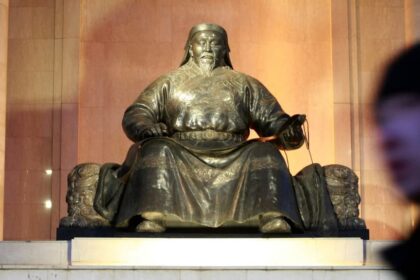The Discovery of Khankhuuluu mongoliensis: A Pivotal Tyrannosaur Ancestor
In a remarkable twist of paleontological fate, a set of fossils that languished in museum drawers for half a century has rewritten the evolutionary history of one of the most iconic dinosaur lineages. The newly identified species, Khankhuuluu mongoliensis—aptly named the “Dragon Prince”—has emerged as the closest known ancestor to the mighty Tyrannosaurus rex, offering a crucial missing link in the tyrannosaur family tree. This discovery, published in the journal Nature, not only clarifies the origins of the tyrannosaurs but also reveals a dynamic story of migration, adaptation, and evolutionary innovation.
- The Discovery of Khankhuuluu mongoliensis: A Pivotal Tyrannosaur Ancestor
- Unearthing the ‘Dragon Prince’: From Museum Drawers to Scientific Breakthrough
- What Made Khankhuuluu Unique? Anatomy and Lifestyle
- Rewriting the Tyrannosaur Family Tree: Evolution and Migration
- Challenging Old Assumptions: The Case of the ‘Pinocchio Rex’
- How Khankhuuluu Sheds Light on Dinosaur Evolution and Biogeography
- From ‘Princes’ to ‘Kings’: The Ascent of Tyrannosaurs
- What Comes Next? Unanswered Questions and Future Research
- In Summary
Khankhuuluu lived approximately 86 million years ago during the Cretaceous Period, predating T. rex by about 20 million years. Unlike its colossal descendant, Khankhuuluu was a mid-sized, fleet-footed predator, measuring about 4 meters (13 feet) in length and weighing around 750 kilograms (1,650 pounds)—roughly the size of a large horse. Its discovery fills a critical gap in the fossil record, illuminating the transition from small, agile hunters to the apex predators that would later dominate prehistoric North America and Asia.
Unearthing the ‘Dragon Prince’: From Museum Drawers to Scientific Breakthrough
The story of Khankhuuluu’s discovery is as fascinating as the dinosaur itself. The fossils were originally excavated in the early 1970s from the Bayanshiree Formation in southeastern Mongolia by paleontologist Altangerel Perle. For decades, these partial skeletons—comprising skull bones, vertebrae, hips, and limb bones—were misidentified as belonging to Alectrosaurus, another early tyrannosaur. It wasn’t until 2023, when University of Calgary doctoral student Jared Voris re-examined the specimens, that their true identity came to light.
Voris noticed unique anatomical features, such as a hollow nasal bone and subtle differences in the bones around the eyes, that set Khankhuuluu apart from previously known species. These observations, confirmed through CT scans and comparative studies with other tyrannosaur fossils, led to the recognition of a new species. As Darla Zelenitsky, a paleontologist at the University of Calgary and co-author of the study, explained, “There’s no doubt this is a new species. There’s also no doubt that it’s the ancestor to these large apex predator tyrannosaurs.”
This rediscovery underscores the value of revisiting historical collections with fresh eyes and modern technology. As Steve Brusatte, a paleontologist at the University of Edinburgh, noted, “So many of us in the paleontology community knew that these Mongolian fossils were lurking in museum drawers, waiting to be studied properly, and apt to tell their own important part of the tyrannosaur story.”
What Made Khankhuuluu Unique? Anatomy and Lifestyle
Khankhuuluu mongoliensis was a predator built for speed and agility rather than brute force. Its long, shallow snout, slender jaws, and blade-like teeth suggest it was adapted to slashing bites, likely preying on smaller dinosaurs such as oviraptorosaurs and ornithomimosaurs. Unlike the massive, bone-crushing jaws of T. rex, Khankhuuluu’s teeth were serrated like steak knives, ideal for slicing rather than crushing.
Another distinctive feature was the presence of tiny horns above its eyes—a trait that would become more pronounced in later tyrannosaur species like Albertosaurus and Gorgosaurus. These horns may have been used for display or intimidation, hinting at complex social behaviors even in these early predators.
Despite its smaller size, Khankhuuluu was no less formidable. As Jared Voris remarked, “You would have been the thing that it would hunt down, and it would have been faster than you. I would much rather run into an adult T. rex than run into Khankhuuluu.” Its build and likely hunting strategy place it as a mesopredator—akin to a coyote in modern ecosystems—occupying a crucial ecological niche between the top predators and smaller carnivores.
Rewriting the Tyrannosaur Family Tree: Evolution and Migration
Before the discovery of Khankhuuluu, the evolutionary path of tyrannosaurs was shrouded in mystery, with a significant gap in the fossil record between early, small-bodied ancestors and the later giants. Khankhuuluu bridges this gap, revealing a complex pattern of evolution shaped by migration and adaptation.
Phylogenetic analyses place Khankhuuluu just outside the group known as Eutyrannosauria, which includes the massive, deep-snouted tyrannosaurs like T. rex and Tarbosaurus, as well as the smaller, long-snouted Alioramini (the so-called “Pinocchio rexes”). The new family tree suggests that Khankhuuluu, or a closely related species, migrated from Asia to North America around 85 million years ago via a land bridge connecting Siberia and Alaska. This migration set the stage for the evolution of true tyrannosaurs in North America.
Over the next several million years, tyrannosaurs diversified and grew in size, eventually giving rise to the apex predators that would dominate the late Cretaceous. Later, some tyrannosaur lineages migrated back to Asia, where they split into two branches: the gigantic, deep-skulled forms like Tarbosaurus and the slender, long-snouted Alioramini. Finally, a giant tyrannosaur species crossed back into North America, leading to the emergence of T. rex.
This back-and-forth migration between continents was less frequent and more consequential than previously thought. As Dr. Zelenitsky explained, “The success and diversity of tyrannosaurs is thanks to a few migrations between the two continents, starting with Khankhuuluu. Tyrannosaurs were in the right place at the right time. They were able to take advantage of moving between continents, likely encountering open niche spaces, and quickly evolving to become large, efficient killing machines.”
Challenging Old Assumptions: The Case of the ‘Pinocchio Rex’
One of the most intriguing outcomes of the Khankhuuluu discovery is its impact on the understanding of tyrannosaur subgroups. For years, paleontologists debated whether the long-snouted, slender Alioramini (such as Qianzhousaurus, nicknamed “Pinocchio rex”) represented the ancestral form of tyrannosaurs. The new analysis, however, shows that these dinosaurs are not primitive ancestors but rather a specialized offshoot that evolved their small size and distinctive features independently within a lineage otherwise dominated by giants.
This finding highlights the role of heterochrony—changes in the timing of developmental events—in tyrannosaur evolution. While the giant forms like T. rex evolved through accelerated growth (peramorphosis), the Alioramini retained juvenile characteristics into adulthood (paedomorphosis), allowing them to coexist with their larger relatives by occupying different ecological niches.
Expert Perspectives on the Discovery
The significance of Khankhuuluu mongoliensis has resonated throughout the paleontological community. Cassius Morrison, a doctoral student at University College London, commented, “It is a pivotal species in understanding the evolutionary success of T. rex and its relatives.” Thomas Holtz, a vertebrate paleontologist at the University of Maryland, added, “It’s a nice new discovery giving us a better sense of what this intermediate phase of tyrannosaur history is like.”
Steve Brusatte emphasized the importance of the fossils’ age: “What makes the specimens so important is their age. They are about 86 million years old, a good 20 million years older than T. rex. It shows that tyrannosaurs were still relatively small at this time, and only later did they become colossal.”
How Khankhuuluu Sheds Light on Dinosaur Evolution and Biogeography
The discovery of Khankhuuluu mongoliensis does more than just fill a gap in the tyrannosaur lineage; it provides a window into the broader patterns of dinosaur evolution and biogeography. The repeated migrations between Asia and North America, facilitated by ancient land bridges, were instrumental in shaping the diversity and distribution of tyrannosaurs. These movements allowed for the exchange of genetic material, the occupation of new ecological niches, and the rapid evolution of new forms.
Such patterns are not unique to dinosaurs. Similar processes have shaped the evolution of many animal groups, including mammals and even humans. As Joseph Sertich of the Smithsonian Tropical Research Institute observed, “The patterns of evolution we are uncovering are revealing a complex story of evolution that goes far beyond tyrant dinosaurs and has bearing on the origins of the modern ecosystems of the Northern Hemisphere.”
From ‘Princes’ to ‘Kings’: The Ascent of Tyrannosaurs
Khankhuuluu mongoliensis represents a critical stage in the ascent of tyrannosaurs from modest, agile hunters to the undisputed kings of the Cretaceous. Its anatomy and evolutionary position reveal how these dinosaurs adapted to changing environments and opportunities, ultimately leading to the rise of T. rex—one of the largest and most formidable land predators in Earth’s history.
As Darla Zelenitsky put it, “Khankhuuluu was where it all started, but it was still only a distant ancestor of T. rex, at nearly 20 million years older. Over a dozen tyrannosaur species evolved in the time between them. It was a great-great-great uncle, sort of.”
What Comes Next? Unanswered Questions and Future Research
While Khankhuuluu has answered many questions about tyrannosaur evolution, it has also opened new avenues for research. Scientists are now eager to explore even earlier stages of the tyrannosaur lineage and to uncover more fossils from the critical period between 90 and 80 million years ago. Such discoveries could further clarify the origins of the group and the factors that drove their remarkable evolutionary success.
The case of Khankhuuluu also highlights the importance of museum collections and the potential for new discoveries among previously collected specimens. As Thomas Carr of Carthage College noted, “A lot of these historical specimens are definitely worth their weight in gold for a second look.”
In Summary
- Khankhuuluu mongoliensis, the “Dragon Prince,” is the closest known ancestor to Tyrannosaurus rex, living about 86 million years ago in Mongolia.
- The species was identified from fossils misclassified for decades, demonstrating the value of re-examining museum collections with modern techniques.
- Khankhuuluu was a mid-sized, agile predator with unique anatomical features, bridging the gap between early small-bodied tyrannosaurs and later giants.
- Its discovery clarifies the evolutionary history of tyrannosaurs, revealing a complex pattern of migration and adaptation between Asia and North America.
- The findings challenge previous assumptions about tyrannosaur subgroups, showing that the “Pinocchio rexes” are specialized offshoots rather than ancestral forms.
- Khankhuuluu’s story underscores the dynamic nature of evolution and the ongoing quest to understand the origins of Earth’s most iconic predators.












